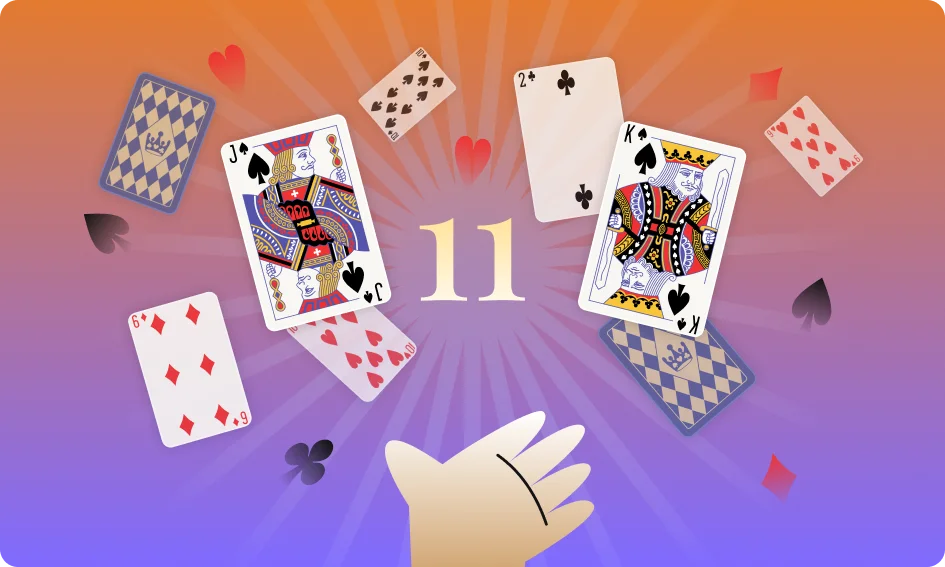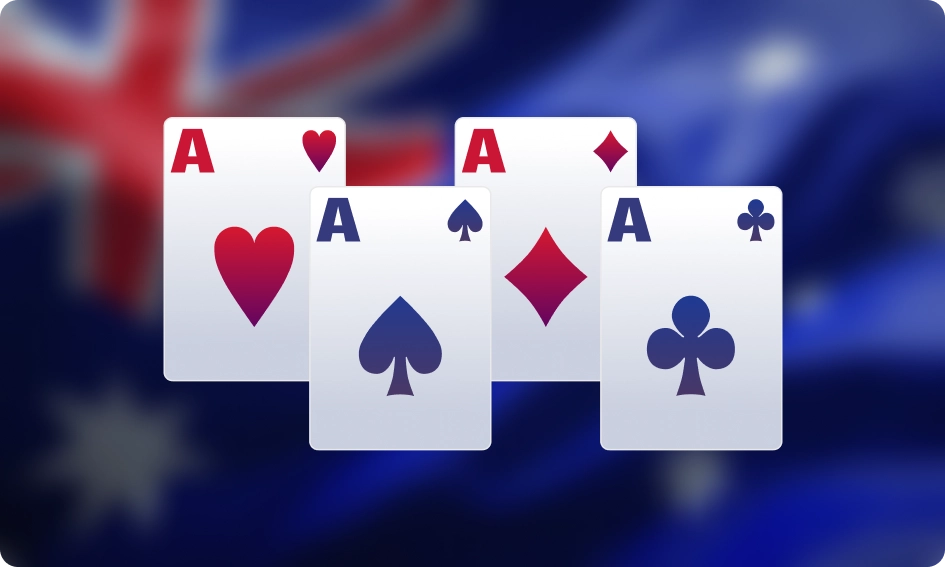As someone who cherishes solitary moments, I have found Solitaire to be a comforting companion. It can also help fight off boredom. Yet, as much as I love the classic Klondike version, playing the same game continuously can become monotonous. If one goes looking, then one will find a treasure trove of one-player card games, each unique in some way or another.
From the challenge of Pyramid Solitaire to the adventures of Devil’s Grip, these one-player games will ensure that you keep coming back for more. Once you play these games, you will surely be hooked (like me). So, close the Klondike tab and prepare for a whole new world of card games.
Pyramid
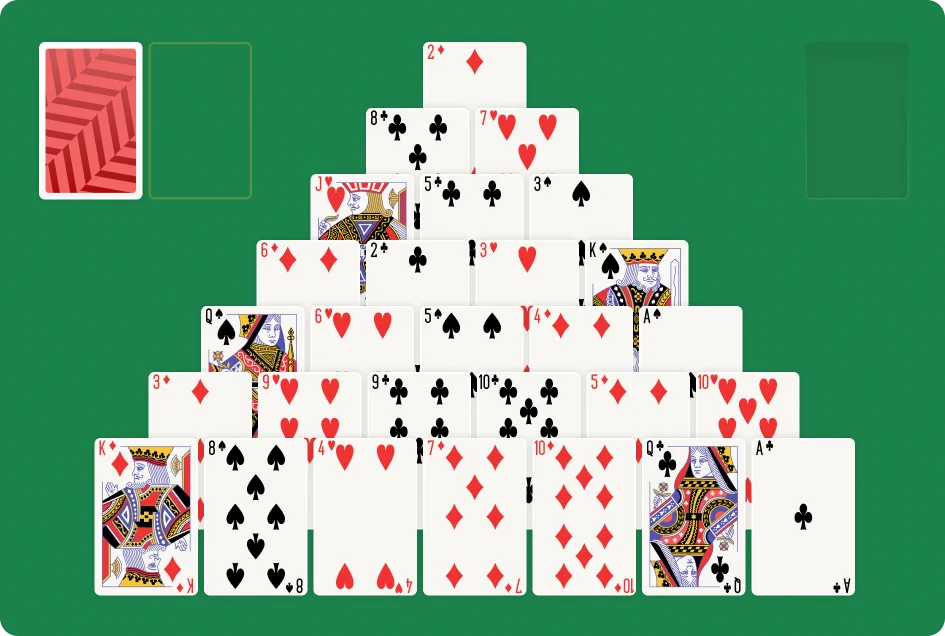
Everyone loves a little challenge once in a while, and Pyramid Solitaire does the job. This Solitaire variant takes the gaming experience to new heights (quite literally). Instead of the traditional tableau layout (where cards are arranged in rows and columns), you will be faced with a pyramid of cards.
I remember when I first encountered this game. The layout took me by surprise. I can tell you that this variant is complex and difficult. It took me several tries just to get a grip on the game. After all, it has a win rate of just 5.5%.
Main Objective
Unlike classic Klondike Solitaire where you build foundation piles, the objective in this game is to clear the tableau by removing all the cards. The difference is that you must remove cards by pairing them to reach a total value of 13. This might sound difficult, and it is. But, it becomes easier as you get a hang of it.
How to Play
- First, take a deck of 52 cards to set up the game.
- Place a card face-up. Now, place a row of two cards on top of it, forming a triangle.
- Keep doing this in sequential order until you make seven rows (the third row will consist of three cards, the fourth of four cards, and so on).
- Set the remaining cards aside for the draw pile.
- Now, look at the tableau and find pairs that add up to 13. For example, an Ace (1) can be paired with a Queen (12).
- Match the cards, and remove the pairs from the tableau.
- If you can’t find any pairs, then you can take cards from the draw pile to uncover more.
- A King counts as 13, so it doesn’t need a pair.
- Continue playing the game until you clear all the cards from the tableau.
Scoundrel
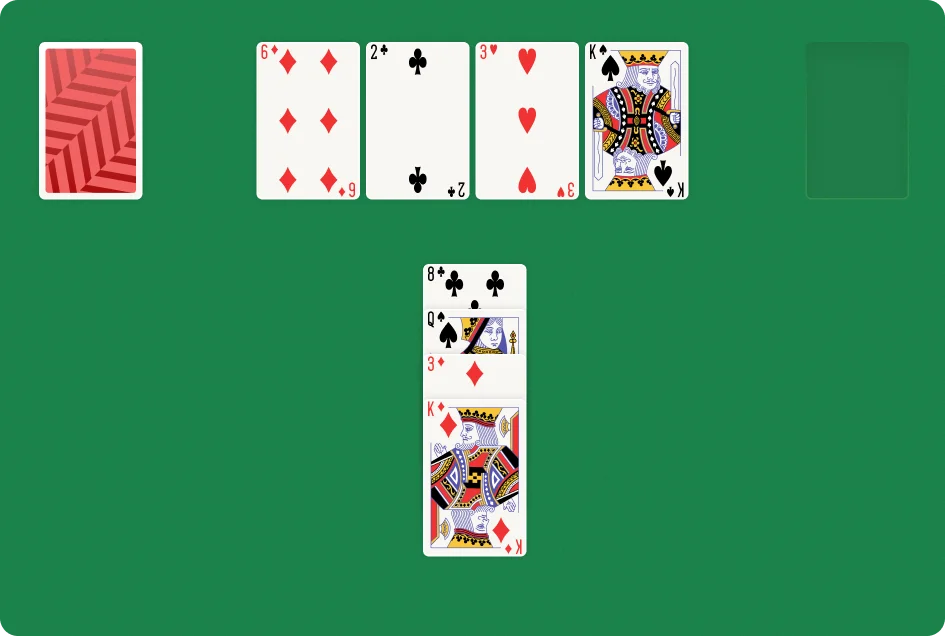
Scoundrel is a very interesting version of Solitaire. With a unique layout, it is made for players seeking unconventional games. But, be aware; this game is quite a bit more difficult than conventional Klondike Solitaire. It took me six fails to just understand the layout!
Unlike many Solitaire variants where you have to clear the tableau, Scoundrel operates in a different realm. Players must navigate through the tableau – also known as the Dungeon – which is filled with weapons and monsters represented by different suits.
Main Objective
Scoundrel’s main objective is to safely navigate through the dungeon while using cards to battle monsters and preserve health. There are four rooms in the tableau, and you must progress through each of them to win.
How to Play
- For the setup, get a 52-card Deck and remove the Jokers, red face cards, and red Aces.
- Each card’s suit has a meaning: Spades and Clubs are monsters, Diamonds are weapons, and Hearts are health passes.
- Turnover four cards, which make up one room.
- You need to clear three cards in each room, as the fourth one will be used in the next room.
- At the start of the game, you have 20 lives.
- You must pass through a room without getting harmed. For example, if you remove a Spades card (which denotes a monster), then you’ll need a Diamond card to fight it.
- If you don’t have the card to beat a monster, then the rank of the monster card will determine the number of lives you lose. For instance, an eight of Spades will remove eight lives.
- But, if you have a weapon to beat the monster, then the difference between the cards will determine the subtraction of lives. For example, a 4 of Diamonds can defeat a 9 of Clubs, but five lives will be deducted.
- You can also skip a room by compiling all four cards in that room and placing them at the end of the stock pile.
- Continue clearing rooms until all the cards are finished.
Beleaguered Castle
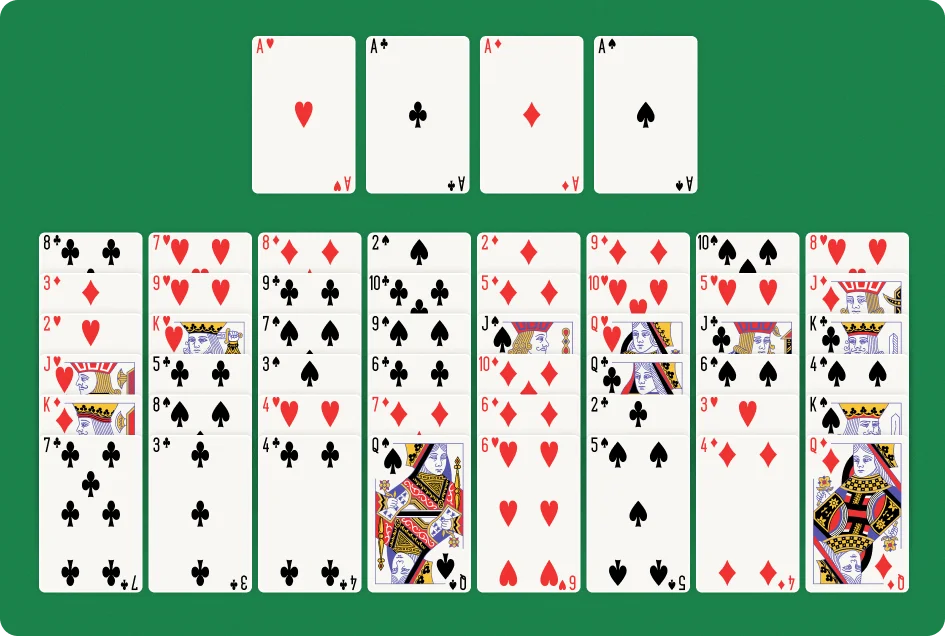
As someone who’s fond of FreeCell Solitaire, Beleaguered Castle is my go-to when I get bored of playing the same game. Dating back to the 1800s, this Solitaire variant is like FreeCell but without the free cells to store cards. The game’s unique layout tends to confuse first-timers within seconds. I mean, the cards are arranged vertically!
Beleaguered Castle has a win rate of 23.75%. It might seem challenging at first, but with the right amount of practice, you can win quite regularly. When I saw this game for the first time, I was skeptical whether I would like it. But, after playing for a while, I realized that it was going to become my comfort game.
Main Objective
The goal in the game is to create foundations from Ace to King in ascending order. So, a foundation pile might start with the Ace of Diamonds and end with the King of Diamonds. If the goal sounds easy, then you’re on the right track. Once I started playing, I began to realize how easy it is.
How to Play
- The game starts with four Aces in the foundation piles. These Aces form the middle column in the setup.
- Place six cards face-up on both sides of the first Ace, respectively. Repeat this with the other three Aces.
- A row of six cards makes a stack. So, in total, there are four stacks on each side of the middle column containing the Aces.
- The foundation is already set; you just need to make sequences in ascending order.
- Any card can be moved from the end of the stack to an empty space.
- Cards can be moved in stacks following a descending order.
- Continue moving cards from the ends of stacks until you make all four foundation piles.
Forty Thieves
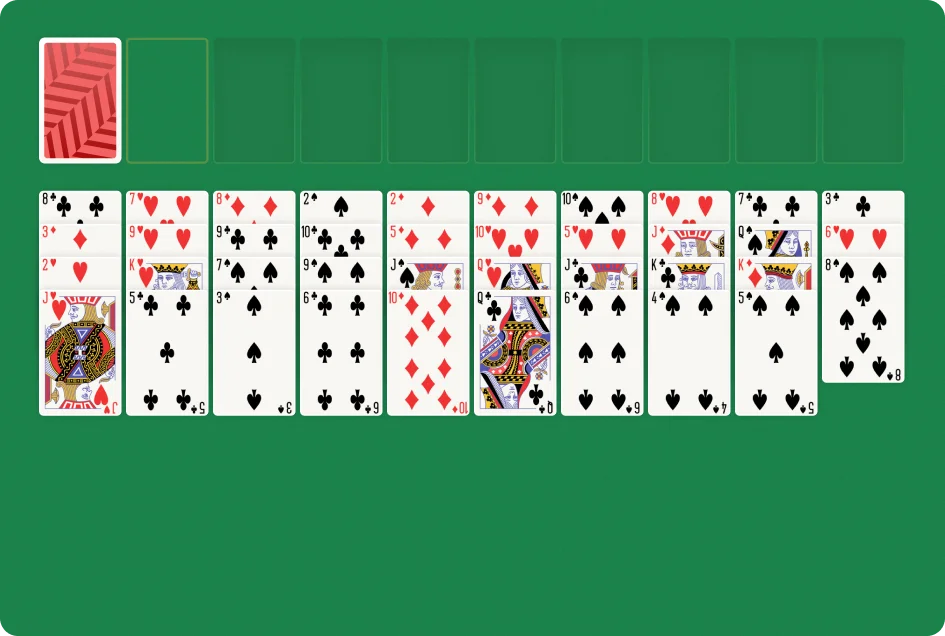
If you’re anything like me, then you revel in challenges that enhance your gaming experience. Forty Thieves is ideal for players like us. Unlike most Solitaire variants, it uses two 52-card decks. The game is very popular and has come to be known by a variety of different names, including Big Forty, Le Cadran, and Napoleon at Saint Helena. Interestingly, I got into this variant when I learned that Napoleon played it after losing the Battle of Waterloo in 1815.
With a win rate of 15 to 20%, Forty Thieves requires all your attention. Instead of the traditional tableau, there are 40 cards in its layout (which is reflected in the name).
Main Objective
The primary goal in Forty Thieves is to clear the tableau by filling in eight foundation piles. The cards will be stacked, starting from the Aces to the Kings. If you’re a regular Klondike player, then you might find this variant difficult because it requires you to form four more foundation piles. However, with a little practice, you can surely perfect this game.
How to Play
- Take two decks of 52 cards and shuffle them.
- Arrange a row of ten face-up cards.
- Next, add an overlapping row on top of those ten, followed by two additional rows of ten face-up cards.
- The remaining cards are your draw pile.
- Now, you need to make sequences from Ace to King and form eight foundation piles.
- You can transfer one card at a time from the tableau to another row or the final piles.
- The cards in the draw deck can be flipped over one at a time.
- Win by finishing all of your piles.
Hope Deferred
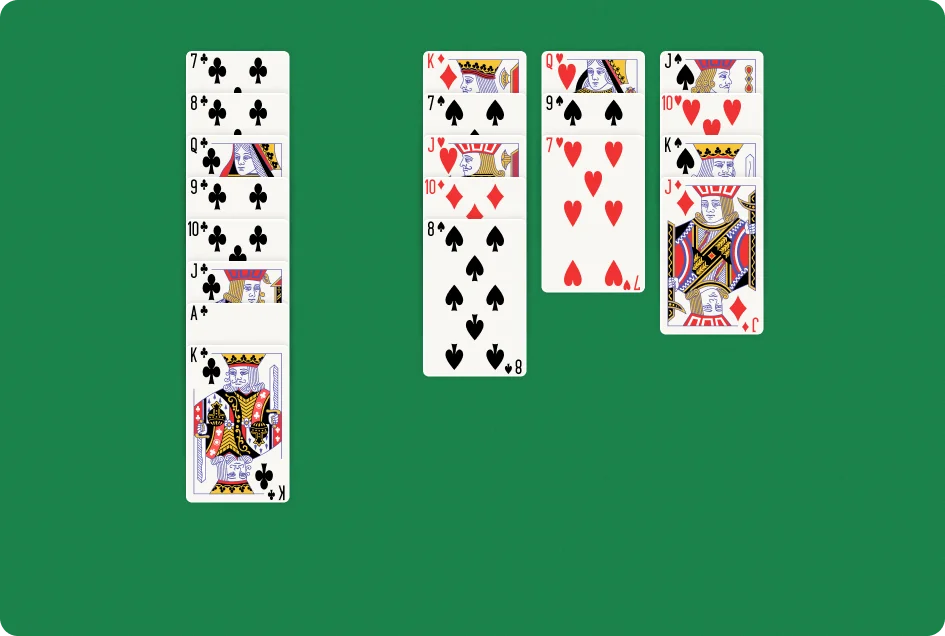
Featuring a Piquet deck of just 32 cards, Hope Deferred is perfect for beginners looking to sharpen their skills. While classic Solitaire variants feature a deck of 52 cards, this one uses fewer cards, which makes things easier. To be honest, I only tried out this game because it has so few cards.
When I first played Hope Deferred, I didn’t have a Piquet deck, so I made one myself. You can create one by removing the Deuces, Threes, Fours, Fives, and Sixes of all the suits in a 52-card deck. So, if you’re worried about a new kind of deck, then don’t fret; there’s nothing difficult about it.
Main Objective
You might be confused about the main objective in this Solitaire variant given that it has fewer cards. But, the game’s primary goal is actually easy to understand. First, you need to know that suits are known as Clubs in this game. Second, you must clear the Clubs by dealing cards in a specific pattern of rows.
How to Play
- Take a Piquet deck and shuffle it thoroughly.
- The game is played with 32 cards ranging from Seven to Ace in each suit.
- The player selects a suit, say Clubs, shuffles the deck, and deals three cards to the table in a row, excluding the selected suit (i.e. Clubs).
- Another three cards are dealt, and the cycle is repeated.
- It is repeated five times, resulting in a total of 15 cards being dealt. Next, you reshuffle the cards (excluding the discards). You then deal another five packs of three sequentially, with any Clubs eliminated each time.
- Finally, you shuffle the cards for a third time and distribute them in groups of three.
- If all of the Clubs are out at the end of the third pass, then the game is won. If any Clubs remain in hand, then the game is lost.
Beehive
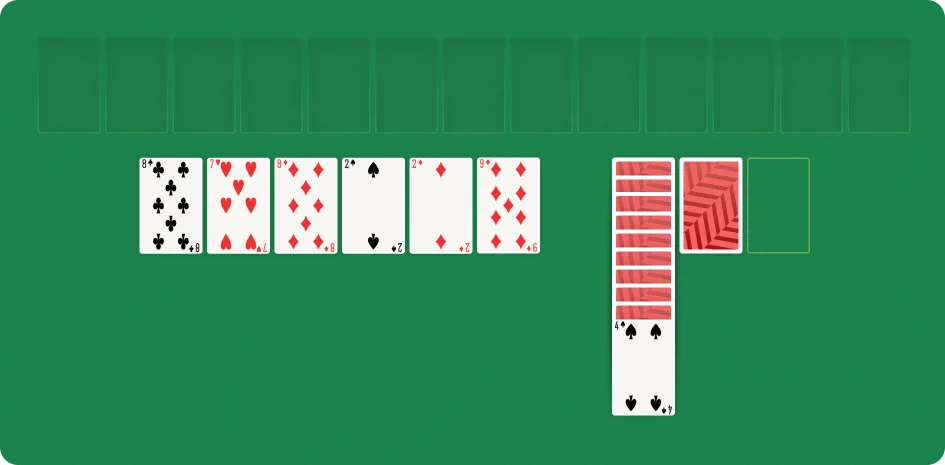
Beehive adds a refreshing twist to classic Solitaire. The tableau is known as the Beehive in this variant. The concept behind the game sounds difficult, but it isn’t. It took me just two to three attempts to master the game. Once you start playing, you’ll realize how easy it is. The bonus is that you get to clear a Beehive rather than a tableau, which makes it more fun than regular Solitaire.
Main Objective
The primary objective in Beehive Solitaire is to get all the cards into groups of four with matching ranks. This goal sets it apart from games like Klondike and FreeCell, where the focus is on building sequences.
How to Play
- The game is set up by laying out a stack of 10 face-up cards to form the Beehive.
- Next, make two rows of three face-up cards.
- Set the remaining deck aside.
- Start by matching ranks in the layout (e.g. Three of Hearts and Three of Spades).
- When there’s an empty space in the layout, you can use the top card of the Beehive to fill it.
- After you’ve used the entire Beehive, you can shift to the remaining deck, which was set aside at the start of the game.
- You have to flip three cards from the deck when using it. These cards form the waste pile.
- Once you’ve made a group of four cards, you can remove it from the layout. The top card from the Beehive then replaces it.
- If you clear all the cards, then you win the game.
Accordion
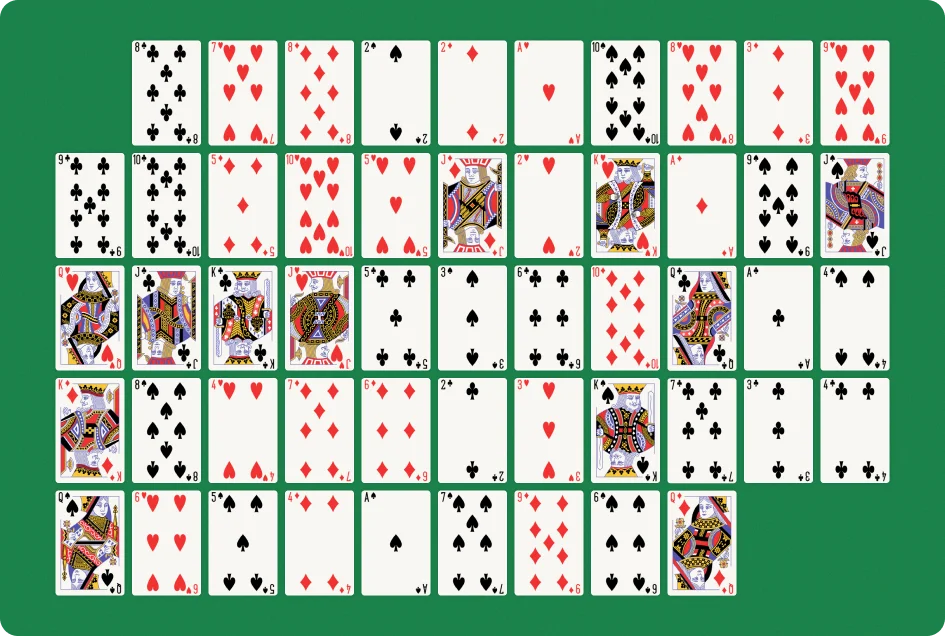
There are only a few Solitaire games that I consider to be extremely difficult. Accordion Solitaire is one of them. With a win ratio of just over 2%, even seasoned experts find this variant very challenging. Before playing the game, I thought it would be easy, but I couldn’t have been more wrong! After just minutes of playing, the complex layout made me quit.
Also known as the Tower of Babel, the game requires players to compress all cards into one pile. This might sound easy, but it’s not. In any event, I can assure you that this challenging variant will surely enhance your gaming experience.
Main Objective
The primary objective in Accordion Solitaire is to gather all the deck cards into one pile. Unlike Klondike, where you must make foundation piles, the cards in this unique variant are placed in a row so that their suit or value gets matched.
How to Play
- Shuffle the 52 cards and deal them face-up, one at a time.
- Have all of the cards in a row. If you run out of room, then proceed down to the row below the first, and so on.
- You can start playing once all of the cards have been correctly set up.
- There are just three rules to remember: (1) Cards can only be built on the left, (2) you can stack a card to the left if the card to its left has the same suit or rank, and (3) a card can be stacked third to the left if it is the same suit or rank.
- It doesn’t matter where you start. You can even start from the center of the group.
- Keep stacking the cards according to the guidelines above. Your objective is to have just one stack at the end of the game.
- You win the game when you’ve placed all 52 cards in one pile.
Bowling
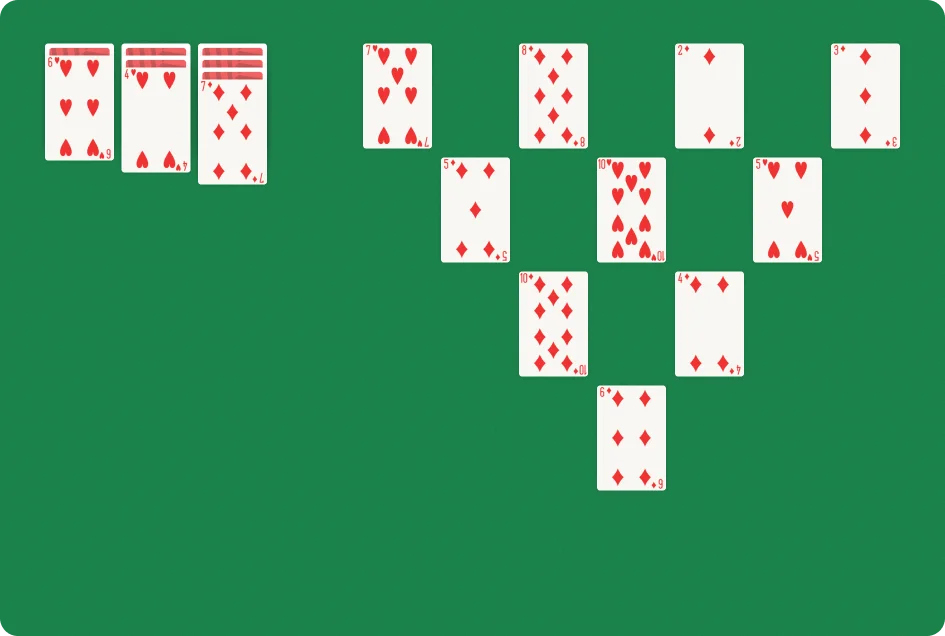
Imagine combining the fun of bowling with Solitaire! Unlike classic Solitaire, in this variant, the cards are referred to as bowling pins. It also has a unique layout; the cards are arranged like a bowling alley. This fascinating aspect initially drew me to the game.
Created in 1969 by Sid Sackson, Bowling Solitaire’s layout can confuse players. I once stopped playing because I couldn’t bear to look at the chaotic layout anymore. The game has a high difficulty level but remains popular among players with different experience levels. From newbies to veterans, the bowling element in this game makes things both entertaining and challenging.
Main Objective
As in traditional bowling, the goal is to knock down as many pins as possible. For each frame, 10 ‘pin’ cards are dealt, with the remaining cards forming three ‘ball’ piles. If one of the pin cards matches one of the ball cards, then you can remove it.
How to Play
- Place the pin cards in four rows. For the first row, place one card face-up. For the second row, place two cards side by side. For the third row, three cards. And, for the fourth row, four cards. This will form the shape of an inverted pyramid.
- For the bowling balls, create three piles with the remaining ten cards.
- Pile one has five cards, pile two has three cards, and the final ball pile has two cards. Place the top cards of each pile face-up.
- Use a standard bowling score sheet to keep track of the score.
- To knock down the pins, you can utilize one of the following: (1) the pin cards and the ball cards have the same value, (2) two or more pin cards equal the value of the ball card, or (3) the last digit of the pin card equals the value of the ball card.
- Each card has a numerical value (an Ace represents 1 point, and so on, up to 13).
- Certain pins can’t be knocked down if others are still standing. For instance, the middle pin in row three can’t be knocked down unless the pins around it have already been knocked down.
- If the ball card does not make a strike, proceed to the second pile of ball cards.
- Complete the remaining ten frames to win the game.
Monte Carlo
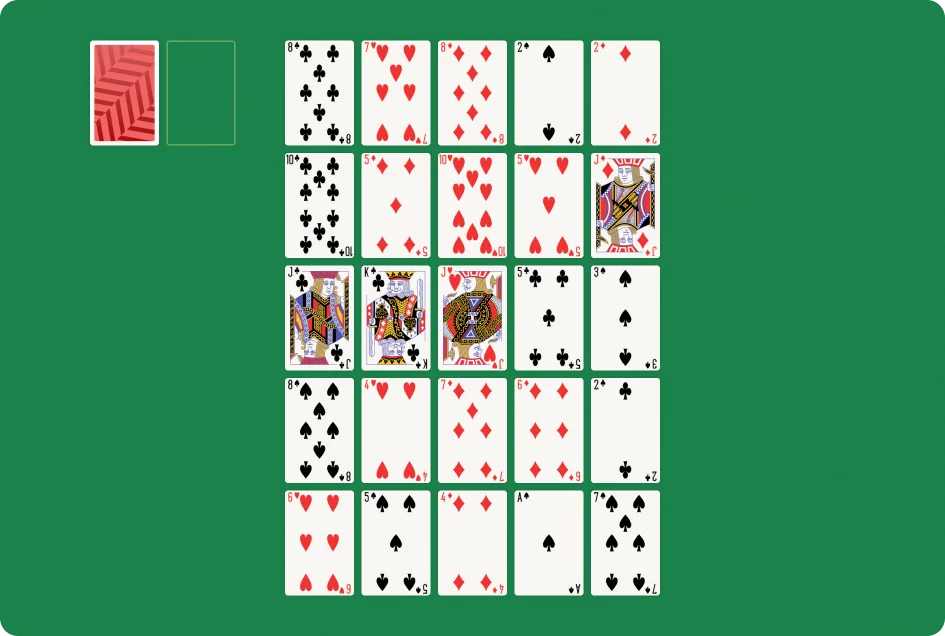
It can get boring to see the same layout in the different Solitaire variants. If you’re like me, then you’re probably looking for a change. Monte Carlo captivates players with its grid-based layout. Unlike classic Solitaire, which features 28 cards in the tableau, Monte Carlo has a layout of only 25 cards; the rest are kept in the stock pile. It might seem challenging at first, but it isn’t that difficult to learn. I learned the ropes after just a few tries.
When I first played the game, I thought it would be related to the city of Monte Carlo, but I was disappointed. The game has nothing to do with either the city or the famous casino with the same name.
Main Objective
The main aim in this game is to eliminate pairs of cards. This can be done horizontally, diagonally, and vertically. This is different from classic Solitaire, where you have to make foundation piles. This might sound complicated, but, trust me, it’s actually quite easy.
How to Play
- Shuffle 52 cards using the rifle technique.
- Assemble a tableau of 28 cards arranged in seven rows and four columns.
- Carefully look at the tableau and analyze it.
- Start matching pairs of cards horizontally, diagonally, and vertically.
- Cards can be matched according to their rank. For example, you can match an Eight of Spades with an Eight of Clubs.
- Keep making pairs until you’ve cleared the tableau.
Osmosis
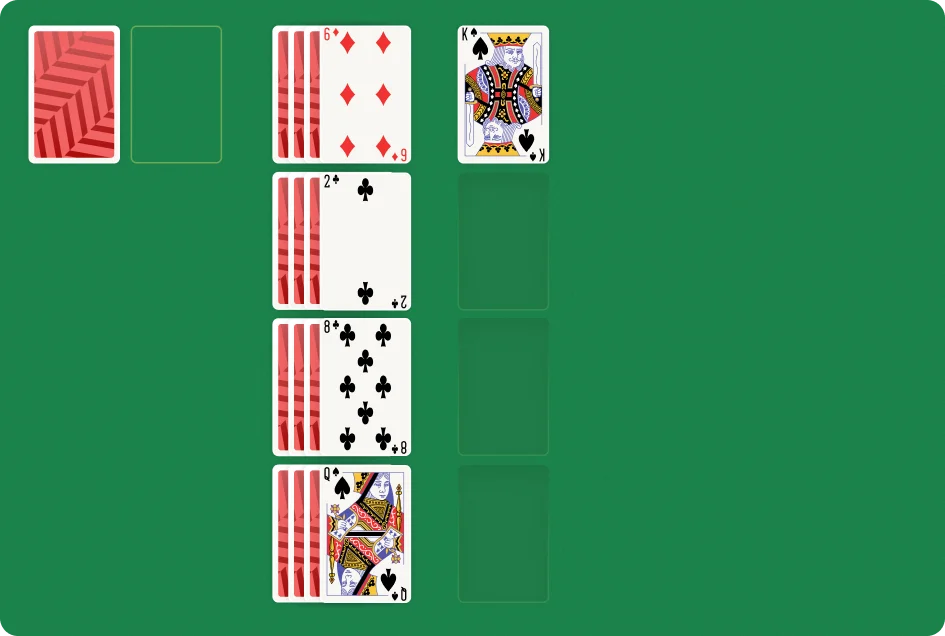
Sometimes, players need to take a break from difficult games. For me, Osmosis does the job. Unlike some of the more complex Solitaire variants, this one is straightforward and easy to understand. This makes it perfect for unwinding after a long day. Due to its simple gameplay, Osmosis allows me to sit back and relax while playing.
Classic Solitaire requires players to clear the tableau by matching cards. In Osmosis, the card order doesn’t matter. You only need to match the suits. The easy gameplay and straightforward rules allowed me to quickly start winning without much hassle.
Main Objective
As with many Solitaire variants, the goal is to arrange the cards in foundations, but not in numerical order. The game’s name reflects the fact that cards with the same value gradually pass through to succeeding foundations ‘via osmosis’. Remember that you just need to make four foundation piles by matching the card suits.
How to Play
- The top cards from the reserves and the discard pile are eligible to be played on the foundations.
- Foundations are built by following suit and according to the “osmosis rule”. This rule states that you cannot play a card to a foundation unless a card with the same rank has already been played to the foundation directly above.
- The top foundation is unique in that there is no other foundation above it. You can place any card onto it if it’s the proper suit.
- If a foundation is vacant, then you can begin with a card of any suit as long as it has not already been played to another foundation. The card’s rank must, though, adhere to the osmosis rule.
Devil’s Grip
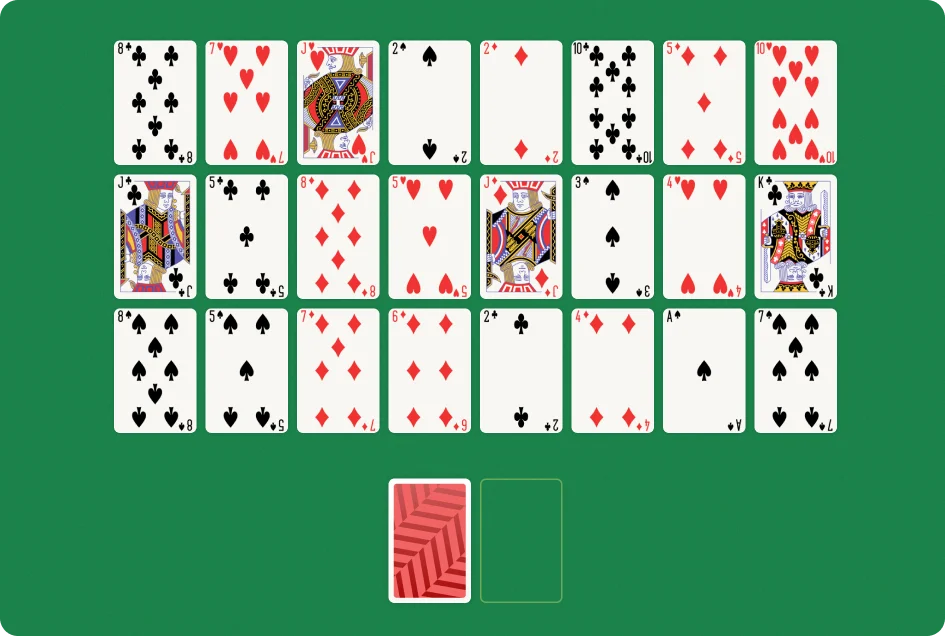
It is sometimes said that the name of something should fully describe it. This is the case with Devil’s Grip. Featuring two 52-card decks, this Solitaire variant is designed for experienced players to sharpen their skills. I was initially afraid of playing this game. After I did so, I realized that my fear was justified.
Considered harder than Spider and Pyramid Solitaire, this variant will take you on a challenging journey. Its difficulty and lack of popularity means that it can be difficult to find this game online. In any event, I can assure you that once you win this game, you will experience a feeling of achievement unlike anything else.
Main Objective
The main goal in this game is to build up piles in sequences and limit the number of cards left in your stock. Unlike classic Solitaire (where you have to make foundation piles), Devil’s Grip has a specific pattern of numbers through which you need to match your cards.
How to Play
- Get two sets of cards and remove the Aces.
- Make a grid of three columns and eight rows consisting of face-up cards.
- Place the remaining cards face-down as the stock.
- Each pile in the top row must be in the order of Deuce, Five, Eight, and Jack of the same suit.
- The middle row must be Three, Six, Nine, and Queen of the same suit.
- The bottom row must be Four, Seven, Ten, and King of the same suit.
- You are allowed to swap the locations of any two cards on the grid.
- You must create the sequences in all rows.
- When a space becomes empty, the top card from the stock fills it.
- If you can’t find any more moves, then you are allowed to use a set of three cards from the stock.
- At the end of the game, count the cards left in your stock to determine your score.
- The closer your score is to zero, the closer you’ve come to winning the game.
Summary of All Card Games
If the long descriptions for each card game are intimidating, don’t worry. The table below contains a brief description of all the games I’ve discussed.
| Name | Objective |
| Pyramid | Clear the tableau by matching cards that add up to 13. |
| Scoundrel | Go through all of the rooms in the dungeon by fighting monsters. |
| Beleaguered Castle | Create four foundation piles from Ace to King in ascending order. |
| Forty Thieves | Make eight foundation piles from Ace to King. |
| Hope Deferred | Clear the Clubs by matching cards in specific patterns of rows. |
| Beehive | Get all of the cards in groups of four with matching ranks. |
| Accordion | Make one pile of all the cards by stacking them to the left. |
| Bowling | Knock down as many pins (cards) as possible. |
| Monte Carlo | Match cards horizontally, diagonally, or vertically. |
| Osmosis | Arrange cards in foundations by matching suits. |
| Devil’s Grip | Build up piles in sequences and limit the number of cards left in your stock. |
Conclusion
These 11 one-player games will ensure that you get to play Solitaire even if you’re tired of the classic Klondike version. From Pyramid Solitaire to Devil’s Grip, you’re in for an enhanced gaming experience. So, grab your cards and learn these 11 games. This will ensure that you sharpen your skills and become a Solitaire pro.


